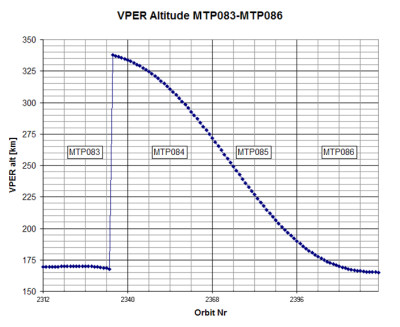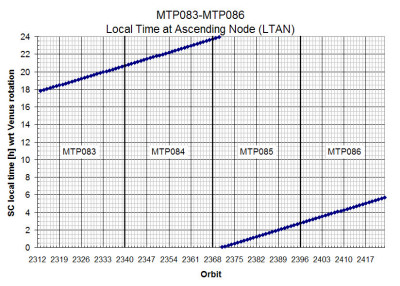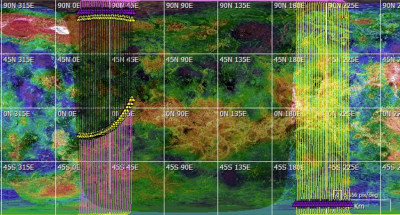No. 253 - Nominal operations and continuation of the twenty-second solar eclipse season
Cebreros ground station
All Cebreros (CEB) ground station activities were nominal during this reporting period.
Regular maintenance of the ground station was scheduled on 5 and 6 November. Such maintenance activities and regular data downlinks from the spacecraft are carried out during the day in order to minimise operational costs. This means that the ground station is unavailable for part of the work day (from 10:00 to 15:00 local time) while maintenance activities are carried out. Thus, the time available for data downlinks from the spacecraft is reduced on days when ground station maintenance is performed.
On 15 October at 06:52 UTC, the CEB ground station experienced an interruption in the telemetry signal, which lasted only a few seconds. The station logs confirmed a clear drop in the signal. The interruption resulted in lost telemetry frames and science packets, which were later recovered. These included one Venus Monitoring Camera (VMC) data packet and three Visible and Infrared Thermal Imaging Spectrometer (VIRTIS) data packets.
The spacecraft's primary High Gain Antenna (HGA-1) was used for Earth communication during this period. The telemetry data rate was 152kbps at the beginning of this period; it was reduced to 114kbps on 19 October. The bit rates are regularly changed as the spacecraft distance from Earth changes, in order to have the maximum downlink bit rate while also maintaining a useful downlink signal.
High accuracy spacecraft ranging
The New Norcia and Cebreros ground stations were used for a Delta Differential One-way Ranging (delta-DOR, or DDOR) measurement on 16 October and 10 November. These measurements are carried out with the Venus Express spacecraft on a regular basis to support the accurate determination of the ephemeris for the planet Venus that is maintained by NASA's Solar System Dynamics Group.
For more information about DDOR, see the "Delta-DOR measurements" link in the right-hand column.
Continuation of the twenty-second eclipse season
Venus Express's twenty-second eclipse season started on 19 September. In preparation, the battery end-of-charge state was raised to 100% (25.2 V) on 17 September, where it will remain until the end of the eclipse season on 19 November 2012.
During solar eclipse seasons, the spacecraft is in complete darkness during a portion of each orbit when Venus blocks out the Sun. At this time, the spacecraft bus and payload are powered by the on-board battery, which must then be recharged to 100% prior to the next eclipse. The battery (composed of three individual battery packs) is sized so that at the end of its life, the spacecraft can go through the longest eclipse and still retain enough stored power for the spacecraft to successfully complete a transition to 'safe mode' in the event of a spacecraft system anomaly.
Outside eclipse seasons, sufficient battery power must be maintained at all times for a transition to safe mode. However, a lower than 100% battery energy level (or end-of-charge state) can be maintained at those times, as no provision is needed for eclipses. Lowering the battery's end-of-charge state prolongs its life.
During eclipse seasons, as viewed from the spacecraft, Venus occults the Sun for part of each orbit. Eclipse ingress and egress observations are made with the Solar Occultation at Infrared (SOIR) channel of the Spectroscopy for Investigation of Characteristics of the Atmosphere of Venus (SPICAV) spectrometer. The SOIR channel is specially designed to measure atmospheric absorption by observing the Sun through the Venusian atmosphere. SOIR solar occultation observations can only be taken during the eclipse seasons, so for this reason they have very high scientific priority in those periods. During this reporting period, SOIR ingress or egress observations were taken in roughly half the orbits. Most of these were ingress-only observations, and were followed by the acquisition of low resolution images of the planet's surface with the Venus Monitoring Camera (VMC).
For more information, see the "Science observations with Venus Express during an eclipse" link in the right-hand menu.
Time correlation
The clock on the Venus Express spacecraft is a simple count-up timer, typical of those used on spacecraft. These clocks save weight and cost but they tend to drift, and must be synchronized - or correlated - with atomic clocks on Earth at regular intervals. One of these regular time correlations was performed on 7 November.
Orbit Correction Manoeuvres
Two Orbit Correction Manoeuvres (OCMs) scheduled for 28 and 29 October were not required and were not executed.
These main engine firings (or OCMs) are performed to ensure that the spacecraft orbital parameters (its orbital period, and apocentre and pericentre heights) stay within a narrow permissible and safe range. The manoeuvres are planned far in advance. If the orbital parameters are found to be within their allowed bands at the time when a manoeuvre is scheduled, and are expected to stay within the permissible range until the next scheduled OCM, then the engine firing can be skipped.
 |
|
Change in Venus Express pericentre altitude during the period from 19 August to 8 December 2012. Credit: ESA |
Summary of main activities
The table below shows a chronology of the main spacecraft bus activities in the reporting period:
| Main activities during reporting period | |||
|
CEB = Cebreros; DOR = Differential One-way Ranging; DOY = Day of Year; MET = Mission Elapsed Time; NNO = New Norcia; OCM = Orbit Correction Manoeuvre; TM = Telemetry |
|||
|
MET (Day) |
Date | DOY | Main Activity |
| 2532 | 14-Oct-12 | 288 | CEB communication pass |
| 2533 | 15-Oct-12 | 289 | CEB communication pass |
| 2534 | 16-Oct-12 | 290 | CEB communication pass. Delta-DOR performed with NNO and CEB support |
| 2535 | 17-Oct-12 | 291 | CEB communication pass |
| 2536 | 18-Oct-12 | 292 | CEB communication pass |
| 2537 | 19-Oct-12 | 293 | CEB communication pass. TM bit rate lowered to 114 kbps after end of CEB pass |
| 2538 | 20-Oct-12 | 294 | CEB communication pass |
| 2539 | 21-Oct-12 | 295 | CEB communication pass |
| 2540 | 22-Oct-12 | 296 | CEB communication pass |
| 2541 | 23-Oct-12 | 297 | CEB communication pass |
| 2542 | 24-Oct-12 | 298 | CEB communication pass |
| 2543 | 25-Oct-12 | 299 | CEB communication pass |
| 2544 | 26-Oct-12 | 300 | CEB communication pass |
| 2545 | 27-Oct-12 | 301 | CEB communication pass |
| 2546 | 28-Oct-12 | 302 | CEB communication pass. OCM slot not used |
| 2547 | 29-Oct-12 | 303 | CEB communication pass. OCM slot not used |
| 2548 | 30-Oct-12 | 304 | CEB communication pass |
| 2549 | 31-Oct-12 | 305 | CEB communication pass |
| 2550 | 01-Nov-12 | 306 | CEB communication pass |
| 2551 | 02-Nov-12 | 307 | CEB communication pass |
| 2552 | 03-Nov-12 | 308 | CEB communication pass |
| 2553 | 04-Nov-12 | 309 | CEB communication pass |
| 2554 | 05-Nov-12 | 310 | CEB communication pass; pass shortened for nominal maintenance activities |
| 2555 | 06-Nov-12 | 311 | CEB communication pass; pass shortened for nominal maintenance activities |
| 2556 | 07-Nov-12 | 312 | CEB communication pass |
| 2557 | 08-Nov-12 | 313 | CEB communication pass |
| 2558 | 09-Nov-12 | 314 | CEB communication pass |
| 2559 | 10-Nov-12 | 315 | CEB communication pass. DDOR performed with NNO |
At the end of the reporting period on 10 November, Venus Express was 196 million kilometeres from Earth. The one-way signal travel time was 654 seconds. The final oxidizer mass was 23.683 kg and the final fuel mass was 14.640 kg.
Scientific focus
This reporting period falls under medium term plan (MTP) 85, which covers the period 14 October to 10 November 2012.
The local time at ascending node changed from 23:40 hrs to 02:40 hrs, making the season 'cold'. This meant that pointing the +Z face (also the instrument face) of the spacecraft towards nadir did not expose any thermally sensitive faces of the spacecraft to the Sun.
 |
|
Venus Express LTAN (19 August to 8 December 2012). Credit: ESA |
The twenty-second eclipse season began on 19 September and continued throughout this reporting period, so priority was given to solar occultations and surface observations in eclipse. Alternate orbits were also devoted to mapping nitrous oxide (NO) on the night side using the Spectroscopy for Investigation of Characteristics of the Atmosphere of Venus (SPICAV) spectrometer, and taking day-side spectrographic images of cloud features at different angles. The data rate during this MTP was medium.
The surface targets included Bell Regio and Central Eistla Regio, both of which are regions of possible volcanic hotspots.
 |
|
Venus Express coverage of Venus (14 October to 10 November 2012). Credit: ESA |
See also the "Science observations with Venus Express during an eclipse" link in the right-hand menu.
Payload activities
The Venus Express science instruments experienced no unusual or anomalous behaviour during this reporting period.
| ASPERA | The instrument was regularly operated nominally as part of the routine plan. |
| MAG | The instrument was regularly operated nominally as part of the routine plan. |
| PFS | The instrument was not operated. |
| SPICAV | The instrument was regularly operated nominally as part of the routine plan. |
| VMC | The instrument was regularly operated nominally as part of the routine plan. One packet that was lost on 15 October due to an interruption in the telemetry signal was recovered. |
| VeRa | The instrument was regularly operated nominally as part of the routine plan. |
| VIRTIS | The instrument was regularly operated nominally as part of the routine plan. Three packets that were lost on 15 October due to an interruption in the telemetry signal were recovered. |
Future milestones
- Pre- Atmospheric Drag Experiment (ADE) torque experiments for the tenth ADE campaign
- End of the twenty-second eclipse season
- Start of the tenth ADE campaign
- Triple planning: Early delivery of three weeks worth of commands to allow for Christmas holidays
- Start of the fourteenth radio science occultation season
---
Legal disclaimer
This report is based on four ESOC mission operations reports, MOR #360 through MOR #363, as well as the MTP85 Master Science Plan. Please see the copyright section of the legal disclaimer (bottom of this page) for terms of use.

